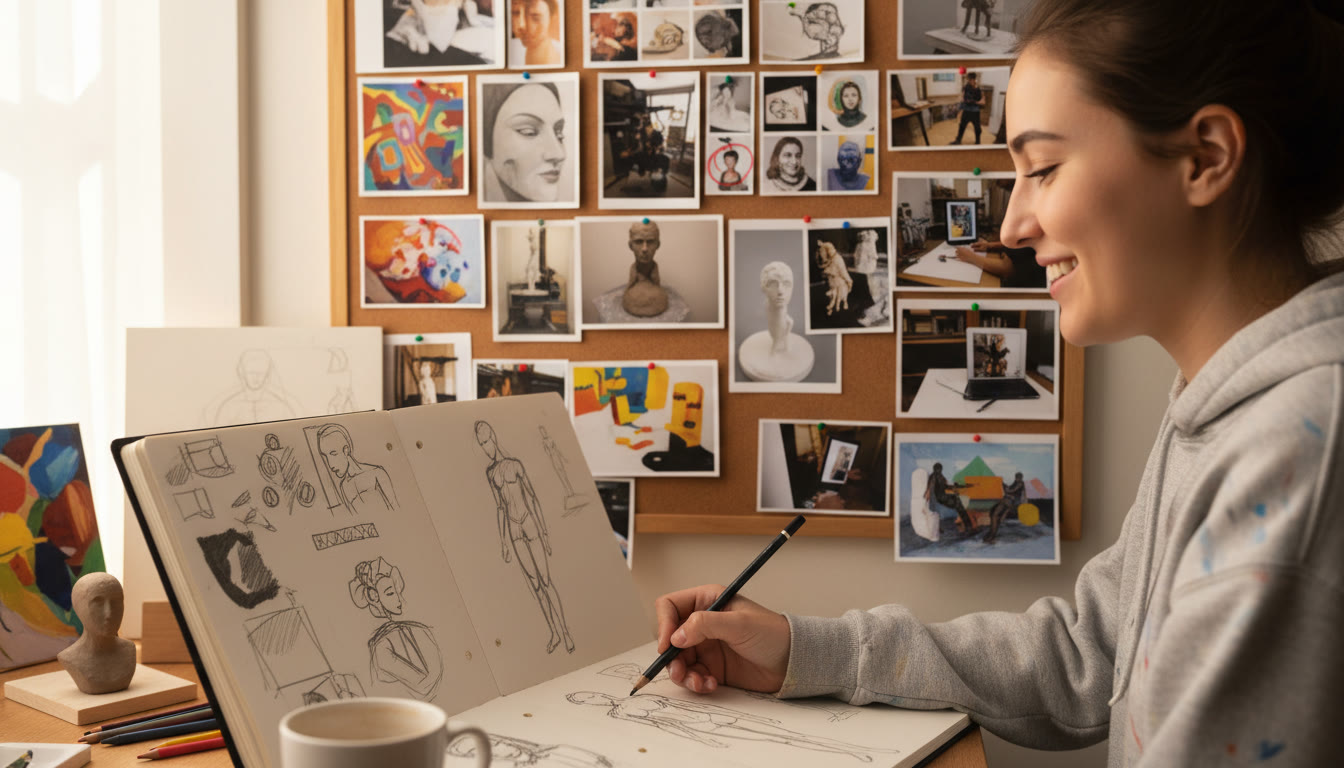Why the Portfolio Statement Matters
When you think about your AP Art and Design portfolio, the images and finished works will understandably take center stage. Yet the portfolio statement — the Intent and the Reflection — is not a mere formality. It’s the voice behind the work. It translates visual choices into meaning, shows your development as an artist, and helps readers (scorers, teachers, college admissions officers) see the through-line in your practice. In short: the statement turns a collection of works into a sustained investigation with purpose.

Understanding the Two Parts: Intent and Reflection
The AP Art and Design portfolio asks for a sustained investigation with two written pieces: an intent (sometimes thought of as an artist statement or project proposal) and a reflection (which documents evolution and decisions). While their purposes overlap, each has a distinct role:
- Intent: What you set out to explore. It answers the “why” and “what” at the outset: your central idea, research, influences, materials, and goals.
- Reflection (Written Evidence): How your investigation evolved. It describes discoveries, revisions, successes, failures, technical experiments, and how specific works connect to your overarching question.
Think of the Intent as a Promise
The intent promises a path. It establishes your initial questions and how you plan to pursue them. It doesn’t have to be rigid or exhaustive; in fact, a strong intent leaves room to discover. Be specific enough to make the investigation credible, but open enough to allow organic growth.
Think of the Reflection as a Map and a Diary
The reflection records the journey. It shows how you followed or revised the original plan, what sparked new directions, and how experimentation affected outcomes. It should refer to concrete works in your portfolio (mentioning titles, techniques, or image numbers when helpful) and explain why these works matter.
Before You Write: Preparation That Makes Writing Easier
Good writing emerges from good record-keeping. Treat the sustained investigation as a research project: document everything.
- Keep a process log: dates, sketches, inspirations, and technical notes.
- Photograph progress states so you can point to specific moments of change.
- Collect sources and influences — artists, articles, exhibitions, films — and note what you borrowed or reacted against.
- Map your works to the investigation question so you can clearly explain how each piece contributes.
Quick Checklist Before Writing
- Do you have a clear research question or central idea?
- Can you name 4–8 works that directly relate to that idea?
- Can you identify at least 2 moments when a technical or conceptual choice altered your course?
- Do you have process photos or notes for those moments?
Writing the Intent: Structure, Tone, and Examples
The intent should be concise but rich. Aim for clarity and authenticity — not grandiosity. Use the following structure as a guide, then reshape to fit your voice.
Suggested Structure for an Intent
- Opening (1–2 sentences): Introduce the central idea or question.
- Context (2–4 sentences): Explain influences, research, or why this topic matters to you.
- Approach and Methods (3–5 sentences): Describe the media, techniques, and processes you planned to use.
- Goals (1–2 sentences): State what you hoped to learn or communicate.
Example Intent (Concise)
“I investigated the visual language of memory by building mixed-media portraits from layered photographs and hand-applied textures. Influenced by archival photography, family snapshots, and the materiality of collage, I sought to explore how fragmented images can evoke emotional truth. I combined digital compositing with traditional materials (tissue, wax, ink) to emphasize the tension between permanence and decay. My goal was to reveal how memory reconstructs identity through selective attention and omission.”
Writing the Reflection: Honesty, Specificity, and Growth
The reflection shows intellectual and artistic growth. This is where you can be candid about experiments that failed, surprising breakthroughs, and how choices shaped outcome. Scorers want to see development, not perfection.
Suggested Structure for Reflection Entries
- Contextual sentence: Which work or moment are you reflecting on?
- What you tried: Techniques, materials, or compositional decisions.
- What happened: Observations — what changed, what surprised you.
- Why it matters: How this shaped subsequent choices or the overall investigation.
Example Reflection Excerpt
“Selected Work: ‘Amber Archive’ — I began by layering family photos digitally, then printed them on rice paper. Initially I expected the translucent paper to blend images subtly; instead, the wax I used caused unexpected pooling that intensified some facial features and obscured others. This accidental emphasis made the images feel more dreamlike, leading me to intentionally exploit wax pooling in later pieces to suggest selective memory. This shift moved my practice away from literal documentary toward a more expressive, tactile language.”
Tips for Tone, Language, and Authenticity
Write in first person and be specific. Avoid vague claims like “This work explores big themes of life and society.” Instead, say what particular aspect of memory, identity, or process you explored. Use accessible language — avoid jargon unless you define it. Aim for an authentic voice: honest about decisions, curious about discoveries, and confident about what you learned.
Language Dos and Don’ts
- Do: Use action words (layered, stretched, printed, stained, erased).
- Do: Cite concrete techniques and materials.
- Don’t: Inflate with clichés (“transcends the medium”).
- Don’t: Over-explain every aesthetic choice — be selective and meaningful.
Common Pitfalls and How to Avoid Them
Many students stumble on the statement in predictable ways. Here are the pitfalls and quick fixes:
- Pitfall: Being too general. Fix: Anchor statements to specific works and processes.
- Pitfall: Treating the reflection like an art review. Fix: Focus on your learning, not on praising the work.
- Pitfall: Overly academic language or verbosity. Fix: Choose clarity and brevity; a clear sentence beats a grand one.
- Pitfall: Lack of process evidence. Fix: Include references to experimentation, photos, or sequence of works.
How to Connect Specific Works to Your Larger Investigation
Think of each selected work as a paragraph in a longer essay. Use the reflection to make explicit connections: why that work mattered, what it taught you about materials, and how it pushed the investigation forward.
| Portfolio Work | Technique/Material | What It Demonstrates | Reflection Focus |
|---|---|---|---|
| Amber Archive | Digital collage, rice paper, encaustic wax | Material transformation of photographs | Accidental wax pooling led to intentional texture use |
| Field Recordings | Ink monotype over photographic underprint | Relationship between mark-making and memory | Layering reduced literal detail, increased emotional focus |
| Object Archive | Sculpted plaster, embedded found objects | Physicality of memory artifacts | Scale influenced viewer intimacy; small pieces invited tactile engagement |
Length, Format, and Practical Requirements
Follow the College Board’s technical and format requirements for written evidence. Be concise: the AP Digital Portfolio will have specific character or word limits for each written element. Respect those limits; clarity within constraints is a valuable skill. If you are unsure about the exact limit for your submission year, check your AP Digital Portfolio student guide or consult your AP teacher/coordinator for the current requirements and deadlines.
Examples: Two Short Intent + Reflection Pairs
Below are two brief examples showing how intent and reflection can pair effectively.
Example Pair A — Conceptual, Media-Focused
Intent: I investigated public versus private spaces by making a series of photographic collages that hybridize storefront signage and domestic interiors. Combining macro photography with screen printing allowed me to blur scale and question what we display publicly versus what we keep private.
Reflection: While making ‘Neighborhood Window’ I discovered that printing on translucent Mylar created a ghosting effect that bridged interior and exterior images. This led me to print multiple layers and stitch them together, introducing a hand-made seam that echoed the seam between public display and private life. The stitching became a motif across later works.
Example Pair B — Material Experimentation
Intent: I set out to explore erosion as metaphor using ceramics and oxidized metals. I wanted to create small sculptures that looked like archaeological remnants altered by time.
Reflection: A glaze I tested produced crystalline textures unexpectedly resembling barnacles. This accident inspired surface experiments where I deliberately encouraged crystallization through salt application. The resulting pieces emphasized the unpredictable role of environment in shaping objects — a core idea of the investigation.
Polishing the Statement: Editing and Feedback
Plan multiple drafts and invite feedback. Ask peers, teachers, or mentors to read for clarity, specificity, and honesty. Here’s a short editing checklist:
- Is the central idea clear in the first sentence?
- Are technical terms explained or used in context?
- Do reflections cite specific works or moments?
- Is the language active and direct?
- Does the statement fit AP Digital Portfolio length limits?
If you’re looking for focused help, Sparkl’s personalized tutoring can be an opportunity to get 1-on-1 guidance, tailored study plans, and expert feedback on artist statements. A tutor can help you tighten language, prioritize evidence, and practice authentic expression without losing your voice.
Authenticity and Academic Integrity
College Board emphasizes original work and honesty in the Artistic Integrity Agreement. Your statement must truthfully represent your process and your authorship. Cite influences honestly — you can (and should) mention artists, texts, or images that inspired you, but be explicit about what you adapted and how your work deviates from or responds to those influences.
Practical Timeline: When to Write Each Piece
Timing your writing matters. A practical timeline helps you capture both the promise and the process:
- At Project Start: Draft a short intent. It can be provisional — a statement of purpose to guide your work.
- Midway Through: Keep process notes and draft reflection snippets tied to each work as you progress.
- Before Submission: Revise intent to reflect any conceptual growth and synthesize reflections into coherent narratives for each selected work.
Final Tips That Make a Big Difference
- Use specific verbs about process (etched, burned, layered, scored) — they paint a clearer picture than adjectives alone.
- Connect emotion to method. If a technique was chosen for psychological impact, say how and why.
- Be concise. Scorers read many portfolios; clear, focused writing stands out.
- Don’t hide mistakes. Show how missteps led to discoveries — that narrative of iteration is central to the AP rubric.
- Proofread for voice and mechanical errors. A confident, clean statement signals care and maturity.

Wrapping Up: Your Statement as Part of Your Artistic Identity
The portfolio statement is your chance to speak for your work. It’s not just an administrative requirement — it’s a vital component that demonstrates you are a thinker as well as a maker. Treat the intent as a committed question and the reflection as evidence that you truly engaged with that question. Be specific, be honest, and let your voice show through.
Finally, remember that strong written evidence grows from strong habits: document, experiment, and revise. If you need targeted support with structure, drafts, or polishing language, consider working with a tutor for dedicated feedback. Sparkl’s personalized tutoring services can offer tailored study plans, 1-on-1 guidance, and expert review to help you refine both your visual work and the statements that explain them — all while keeping your voice central to the portfolio.
Quick Reference: Writing Do’s and Don’ts
- Do: Open with a clear research question or central idea.
- Do: Connect specific works to the investigation with concrete details.
- Do: Use plain, precise language and active verbs.
- Don’t: Use vague platitudes or clichés.
- Don’t: Present reflections as sales pitches — focus on learning, not persuasion.
- Don’t: Ignore technical or format requirements for digital submission.
One Last Thought
Your portfolio is a record of curiosity, practice, and growth. The intent and reflection are how you make that growth legible. Write with humility and confidence — humility because art is a process of discovery, confidence because your sustained investigation proves that you are a serious, thoughtful creator. Good luck, and enjoy the process of telling the story of your work.














No Comments
Leave a comment Cancel